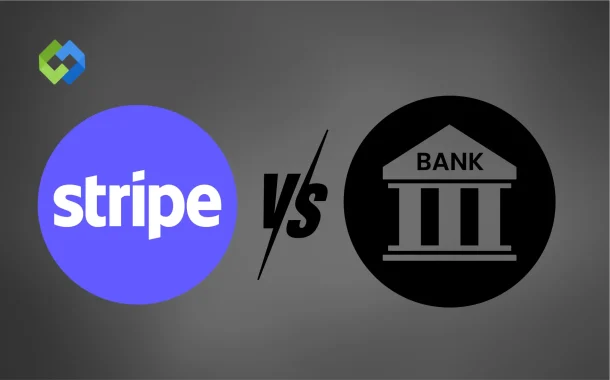Businesses often compare Stripe and bank transfers to decide which one fits their needs better. Stripe offers quick online payments and easy integration for eCommerce stores. Bank transfers, on the other hand, are direct and reliable for large transactions. The choice depends on factors like transaction fees, speed, and payment type.
Table of Contents
Table of Contents
How Stripe Payments Work
Stripe payments work by allowing businesses to accept online transactions securely and quickly. When a customer buys something, Stripe processes the payment in the background. It verifies the card information, checks for fraud, and ensures the payment is authorized before completing the purchase. This makes the process simple for both businesses and customers, as everything happens within seconds.
Stripe supports many payment types, including credit cards, debit cards, and mobile wallets like Apple Pay and Google Pay. It also allows payments in multiple currencies, which makes it ideal for global businesses. Customers can pay directly on the website without being redirected, offering a smoother and more professional checkout experience.
Behind the scenes, Stripe acts as a middle layer between the buyer’s bank and the seller’s bank. It securely transfers funds using encrypted connections to protect sensitive information. After successful payment, Stripe deposits the money into the business’s account balance.
How Bank Transfers Work
Bank transfers work by moving money directly from one bank account to another. This process can be done through online banking, mobile apps, or by visiting a bank branch. The sender provides the receiver’s account details, such as the account number and bank name, to complete the transaction. Once the details are verified, the bank processes the transfer and sends the funds securely. This method is simple, reliable, and widely used for both personal and business payments.
There are two main types of bank transfers. Domestic transfers are faster and usually take a few hours or a day to complete. International transfers can take several days because they involve more than one bank and may include currency conversion.
Bank transfers are known for their security since they move money directly between trusted banks. They can be slower and sometimes have higher fees, especially for global payments. Still, many businesses choose them for large and regular transactions.
Differences Between Stripe and Bank Transfers
| Feature | Stripe | Bank Transfer |
| Payment Method | Online payment gateway for cards and digital wallets | Direct transfer between bank accounts |
| Processing Speed | Instant or within minutes | Can take hours or several days |
| Ease of Use | Easy to integrate with websites and apps | Requires manual entry or bank confirmation |
| Transaction Fees | Charges a small fee per transaction | Fees vary by bank and may depend on location |
| Security | Encrypted and PCI-compliant for online payments | Highly secure, protected by banking systems |
| International Support | Supports multiple currencies and global payments | International transfers may take longer and cost more |
| Automation and Tracking | Offers dashboards, analytics, and refund tools | Tracking is manual and less flexible |
| Best For | Online businesses, eCommerce, and digital services | Large payments, business-to-business transactions, and traditional banking |
Pros and Cons of Using Stripe
Advantages of Using Stripe
- Stripe processes payments quickly, usually instantly or within a few minutes, which helps businesses get paid faster.
- It supports multiple payment methods, including credit cards, debit cards, and digital wallets like Apple Pay and Google Pay, giving customers more choices.
- Integration with websites and apps is simple, providing a smooth and professional checkout experience for users.
- Stripe offers tools to track transactions, manage refunds, and handle subscriptions, helping businesses save time and reduce errors.
- It supports multiple currencies, which is useful for businesses that sell internationally.
Limitations of Using Stripe
- Stripe charges a fee for every transaction, which can add up, especially for businesses with many small payments.
- Some advanced features, like international transfers, recurring billing, or analytics reports, may require extra setup or additional costs.
- Payments cannot be processed offline since Stripe relies entirely on internet connectivity.
- Businesses must follow Stripe’s rules and compliance requirements, which can limit flexibility in certain cases.
- Although secure, managing refunds or disputes may still require manual intervention in some cases.
Pros and Cons of Using Bank Transfers
Advantages of Using Bank Transfers
- Bank transfers move money directly from one account to another, making them highly secure and reliable.
- They are ideal for large payments because banks can handle high-value transactions safely.
- Domestic transfers are usually fast, often completed within the same day, depending on the bank.
- Bank transfers are widely accepted, making them suitable for business-to-business payments and traditional transactions.
- They are straightforward, with no need for additional payment gateways or online tools, which is convenient for some businesses.
Limitations of Using Bank Transfers
- International transfers can take several days due to multiple banks and currency conversions, making them slower than online payment systems.
- Banks may charge higher fees for cross-border or large transactions, which can increase costs for businesses.
- There is less automation and tracking compared to platforms like Stripe, so monitoring payments can be time-consuming.
- Manual entry of account details is required, which increases the chance of errors during transactions.
- Customers cannot use cards or digital wallets directly, which may limit payment flexibility for online sales.
Which Option Is Better for Businesses
Choosing between Stripe and bank transfers depends on how your business operates and what your payment needs are. Stripe is best for online businesses that need fast and flexible payment options. It allows customers to pay using credit cards, debit cards, and digital wallets like Apple Pay and Google Pay. This makes it ideal for eCommerce stores and businesses that serve international customers. Stripe also provides tools for tracking payments, handling refunds, and managing subscriptions, which helps simplify day-to-day operations.
Stripe is also easy to set up and integrate with websites and apps. Businesses can start accepting payments quickly without complicated technical work. Its reporting and analytics tools help track sales, monitor cash flow, and understand customer behavior. This makes Stripe useful for businesses that want both convenience and insight into their financial operations.
Bank transfers, on the other hand, are more suitable for large or high-value transactions. They move money directly from one account to another, which makes them very secure. They are commonly used in business-to-business payments or situations where large sums of money are involved. Bank transfers also reduce the risk of chargebacks since payments cannot be reversed once completed.
Conclusion
Both Stripe and bank transfers have their own strengths. Stripe is fast, convenient, and works well for online payments. It supports cards, digital wallets, and international transactions. It also offers tools for tracking payments, handling refunds, and managing subscriptions.
Bank transfers are secure and reliable for large payments. They have lower risks of chargebacks and are widely trusted by customers in certain regions. The choice depends on your business needs. If you need speed and online convenience, Stripe is better. For large or traditional transactions, bank transfers work well. Consider your customers and payment requirements before deciding.














